 Writing a press release. Want to improve your chances of standing out and getting your story heard? And know the kind of information to include? And have the skills to present a release for a busy newsroom? Can you grab the attention of a hard pressed news journalist? And keep their interest.
Writing a press release. Want to improve your chances of standing out and getting your story heard? And know the kind of information to include? And have the skills to present a release for a busy newsroom? Can you grab the attention of a hard pressed news journalist? And keep their interest.
Writing your first release can be daunting. But here you will find all you need to put together a compelling press release. Plus a template to help get you started.
Contents
What is a press release?
The press release is a means of reaching the news media. A well-written release is the key to getting your story published.
You have information you wish to publicise. Your ultimate aim is to convince a news editor that your story is newsworthy and will interest the wider public. So, your first step is to present your information in such a way that it will attract the attention of a news editor and your intended audience.
 Written in third person, you simply offer an interesting news item. For instance, “it” or “they”. Direct personal address, such as “you,” “I,” “we,” works well in conversation and advertising, but cosying up has no place in a news report. Keep the tone objective and factual.
Written in third person, you simply offer an interesting news item. For instance, “it” or “they”. Direct personal address, such as “you,” “I,” “we,” works well in conversation and advertising, but cosying up has no place in a news report. Keep the tone objective and factual.
Aim to give journalists information that’s useful, accurate and interesting. Useful, accurate and interesting, it’s that easy.
Getting published is like receiving an endorsement of your work, your message and you. It gives you credibility and raises your profile. And remember, getting your publicity broadcast as news is far cheaper than paying for an advert.
Other considerations when writing a press release
I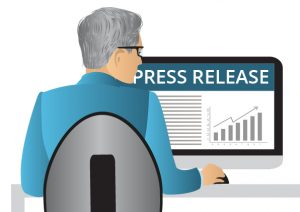 n today’s world, press releases are an essential part of online marketing and digital communication. They are usually sent via website or by email. They can also be part of a full press kit with photographs, accompanied by a covering letter. However, not many people use the post now.
n today’s world, press releases are an essential part of online marketing and digital communication. They are usually sent via website or by email. They can also be part of a full press kit with photographs, accompanied by a covering letter. However, not many people use the post now.
Few people understand how a press release should be structured. But, there are basic elements which should be common to all of them.
You may decide to hire a journalist or other expert to undertake writing a press release on your behalf. Even so, to evaluate its success, you will need to know what should go into a good press release.
How a press release is used
 Because the media have a powerful voice, they shape the lives and opinions of millions of people. Which type of publication (newspaper, local radio, TV, magazine) you approach, will influence your chances of getting published.
Because the media have a powerful voice, they shape the lives and opinions of millions of people. Which type of publication (newspaper, local radio, TV, magazine) you approach, will influence your chances of getting published.
Local newspapers and radio stations are hungry for good news stories. So, they are likely to welcome your initiative. Regional television companies will be looking for the strongest stories with the most outstanding pictures. Trade and other specialist magazines may be good targets because their circulations are relatively small and their articles are more focused.
Before you start writing, take time to study these media and try to spot the stories that have come from a press release. You will also notice that newspapers and magazines vary from each other in style and content. Write your press release with their needs and readers in mind.
It’s much harder to get your release published in national newspapers and consumer publications. They have high circulation figures and a wider range of interests. Remember too that your press release will be one of a huge number of releases a newsroom receives each day. If it stands out as interesting, relevant and newsworthy, you will have a better chance of publication.
Why do you want to issue a press release?
A press release may contain details of an event you are organising or perhaps an invitation to attend a photocall. For instance:
- Introduce a new product or service
- Publicise a future event, anniversary or milestone
- Advertise an open day, seminar or conference
- Announce a new appointment
- Put the record straight or protest
- Update your target audience on a matter
- Build awareness of your organisation
- Publicise a new discovery or scientific breakthrough
- Announce an award
- Appeal for donations
- Call for volunteers
Be clear what you are trying to achieve. Make sure you are approaching the media for the right reasons.
What to consider before you start writing a press release
 Is your information newsworthy?
Is your information newsworthy?
What do you want to say? Think carefully what your main message is. Can you explain it in a simple and clear way? Highlight the most interesting part of the story or event you want to publicise.
Ask yourself these questions:
- Is this something that people need or want to know?
- What is unique about this story?
- Is it a first, is it the only event held like it in your region?
- Can you explain it in a simple and clear way?
- Will it affect many people?
- In short, is it newsworthy?
Not everything is news. Before you approach a journalist, or even begin to write, remind yourself of what is newsworthy. Take a look at the Introduction and News values that drive today’s top stories sections on my news values page. This will enable you to spot a story that is deserving of publication.
Who will be interested?
Know your target audience. Which newspapers, journals, radio stations or television companies will best broadcast your message? Read a few issues of their publication, or listen to their style of broadcasting. Spend some time reading their website.
When deciding where to pitch your story, make sure:
- their readership or viewership fits your intended audience
- your product, service or event is within their coverage area
 So, for instance, the readers of a niche magazine will be very different to those that read the local newspaper. If you’re a software company, ask yourself why a publication that writes about commercial vehicles, would run your story?
So, for instance, the readers of a niche magazine will be very different to those that read the local newspaper. If you’re a software company, ask yourself why a publication that writes about commercial vehicles, would run your story?
Why not write different versions of your release for the different audiences you are targeting? Consider what knowledge they have about your company and product, and the type of language they will best understand. The language used to describe production processes, for instance, might be relevant for a specialist engineering audience, but not for the general public.
Having established the best news outlets, take a look at each of them and analyse the style of articles and, where appropriate, the pictures they use. The closer you can match their style, the more likely your article will be used.
When to send out your information
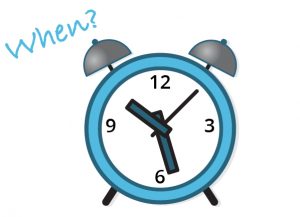 Be timely. Pick the right moment to make your announcement.
Be timely. Pick the right moment to make your announcement.
You may want to hold back your press release from publication until a later time. For instance, you could provide some advanced information before making an important announcement at a press conference. You might want to send out a preview of a product ahead of its release date, or send out a copy of a presidential speech several hours in advance. If so, you need to mark your release as ’embargoed’.
The embargo requests news organisations to refrain from publishing the story until a specified time and date. This has the added advantage of stimulating interest and giving sufficient time for journalists to prepare their stories. But be careful. What you say in advance could also reduce your impact.
You can embargo your whole press release, or just a part of it, and you can specify the precise time when you want the story to be made public. Just add the words: ‘Embargoed until…’ before your specified date and time. Editors are not duty bound to observe an embargo, but on many occasions they will.
If you want your story to be reported straight away, include the words: ‘For immediate release’.
Assemble your facts
An interesting and concise story will engage the attention of a news journalist as they read your press release. Before you start writing, be clear and think through exactly what you want to say.
Six key questions to ask
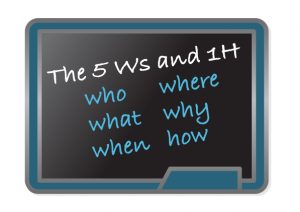 Journalists learn there are six questions that must be answered for a story to be complete. Every press release should answer all six W questions. Or, more accurately, the Five Ws and One H, who, what, when, where, why and how.
Journalists learn there are six questions that must be answered for a story to be complete. Every press release should answer all six W questions. Or, more accurately, the Five Ws and One H, who, what, when, where, why and how.
If you are writing about an event you want to publicise, say what it is, and where and when it is taking place. You also need to explain who you are and why you have organised the event.
When you have written your press release, make sure you have answered these questions:
- Who – are the key players? Who does your news affect and who does it benefit?
- What – is it about? What is new?
- When – will it happen?
- Where – will it happen?
- How – will it take place?
- Why – is it happening? Why is this important?
(Short story writer and author, Rudyard Kipling, knew the value of these 6 key questions).
News stories are about providing information, and so there is nothing more frustrating than a story with unanswered questions.
Journalists love facts and figures, particularly if they’re relevant to their particular concern. Wherever possible, use crucial facts, such as how many people are taking part, to substantiate your story. Arrange your questions in the right order. Then start describing the facts clearly in your draft.
Structure your Press Release
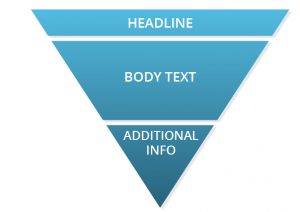 Armed with answers to the six W questions, you can now structure your press release. There are basic elements which should be common to all press releases.
Armed with answers to the six W questions, you can now structure your press release. There are basic elements which should be common to all press releases.
Use the inverted pyramid. This enables you to present the most important information first.
Headline
- Take time to craft your headline so it tells the story. Use simple but powerful language. Avoid words that are bland, uninspiring, or unfamiliar.
- Ask yourself what is new. Identify your news angle. And then tell your story as it is.
- Summarise your story. Keep it short and simple using no more than ten words in bold type. This will force you to focus on the story.
- Include four to five news points. Make sure they are within that one short sentence.
- Don’t try to be clever. You risk smothering the story itself. Most journalists will spend just a few seconds to decide if a press release looks interesting. If they don’t immediately understand what your story is about, they’ll move on to another one.
- Use your headline as your email subject line. Make sure it’s a good headline, then use it. There’s no point in creating a brilliant press release if the news editor fails to open your email.
Writing the body of your text
Make sure your paragraphs are cohesive and each flows well from the previous one. They should be no longer than three or four sentences in each paragraph. Aim for the length of an A4 page. And certainly no more than two. A total of 400-500 words should be sufficient.
Craft your opening paragraph to contain the gist of your announcement. Put all the key information here. Try to answer all the 6W questions. A busy news editor may have time only to read your first para. So, it must contain all the basic information about your new product, discovery, event or latest initiative.
Wrap up your text with a compelling last paragraph. This should provide the vital facts about your event, product or service, and who to contact.
Tone and style
- Write like a journalist. Pitch your story so it captures the editor’s attention. So, say upfront what the purpose of your press release is and make it succinct.
- Arouse your reader’s interest. News is about exciting or unusual events. Always place the most interesting fact in your opening paragraph. These may be the only words that get read. Newsdesks are inundated with press releases. So, make sure yours catches the editor’s attention or it may go straight into the bin.
- Keep to the facts and be scrupulously accurate. Present only information that is true, correct and doesn’t embellish anything that is to be communicated. Ensure your sources are quoted accurately.
- Make sure your text is grammatically correct. Remove any errors or spelling mistakes. Take special care to ensure the correct spelling of names – both of people and organisations.
- Be succinct and remove cliches. Avoid unnecessary fancy language, such as ‘state of the art’, ‘cutting-edge’, ‘revolutionary’. Overused idioms have long since lost their impact.
- Keep your text precise and punchy. Use plain English. Say what you mean. Make sure your reader understands what you have said and everyone is on the same wavelength.
- Be objective. Okay, that’s almost impossible to do, but refrain from using over-hyped claims that might be seen as being unreasonably biased.
- Be original. If you’re promoting your tenth anniversary, all well and good. But if it’s your 27th annual event, you may need something fresher and more gripping to attract attention.
- Try to be topical. If that is impossible, incorporate your message with a more recent news event that everyone is talking about.
Use quotes
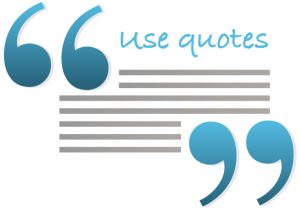 Quotes from people involved in your announcement will really help liven up your release, but make sure they are concise and relevant to the story. They add colour and an authoritative voice to your release.
Quotes from people involved in your announcement will really help liven up your release, but make sure they are concise and relevant to the story. They add colour and an authoritative voice to your release.
A good quote will support rather than simply repeat text of your release. A few words from an expert or someone involved in your event will add credibility. A professional voice can take you far. But try to avoid cramming too many points in one quote.
There’s a strong chance a quote will be included in a published article, so do check its accuracy with the person quoted. Never be tempted to make up a quote and attribute it to someone without their permission.
What else to include in your press release
 Add photos
Add photos
If you have pictures to use with your press release, supply them. Not only are the press looking for original stories, they are also on the alert for good eye-catching pictures.
From the moment you decide to approach the media, ask yourself how compelling your story will be. Will the action make a good photo? Will the picture reinforce your message? Can you take a picture in advance of the occasion? With a little thought and help you can easily improve your news photos.
Although it is not essential, you could include photos of people, or your colleagues with your release. A good crowd may help. This will remind the press that your project is alive, not just words on a piece of paper. It might also encourage photographers and television crews to come to your event, especially if there are obvious visual draws.
Remember a journalist is looking for a good story. A head and shoulders picture may show what your subject looks like, but a picture showing them in action will generate more interest. Try to think creatively.
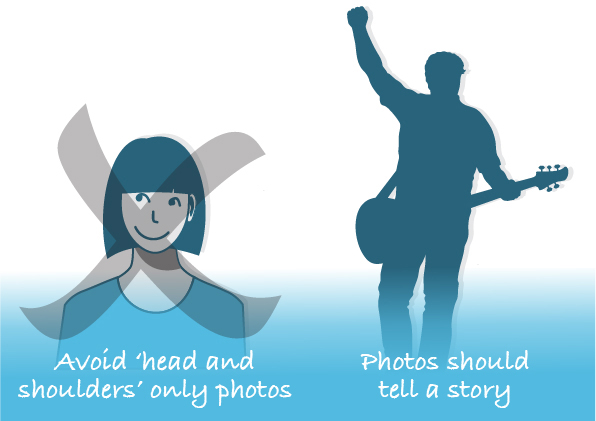 Choose your background wisely. Pictures that have large logos in the background can be a huge turn off.
Choose your background wisely. Pictures that have large logos in the background can be a huge turn off.
Always include a caption with photographs. If several people are included, state “Left to right…” then list the people in the shot and any further detail that’s relevant, such as “where” and “when”.
If you are planning a spectacular event, decide if you want to stage a photocall. Local newspapers are working with tight budgets, but they may be prepared to send out a press photographer if the opportunity warrants it.
A good picture is worth a thousand words. A bad picture is worse than no picture at all.
Contact details
Always give the email and contact number of the relevant PR or business contact. You may wish to add a postal address. These details can be placed after the main text of your press release.
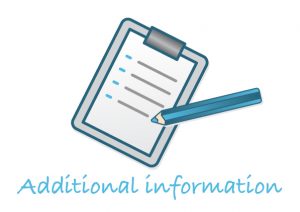 Additional information
Additional information
It may be helpful to send additional information to editors so they can flesh out the story.
You may have useful facts about the people mentioned or quoted in your release. These can be presented on another page entitled Notes to Editor.
Notes to editor
It’s good practice to add a “Notes to editor” section at the end of your press release. This contains information that’s useful for the media, but doesn’t need to be included in the actual story:
- A short biography of the people mentioned in the press release
- What additional assets are available, for instance, photographs, videos and interviews
- Plans for events, such as a press conference, its location, arrival time and who will be available for interview
- A brief overview, sometimes called a “boilerplate”, with background information about the organisation that features in your press release
Boilerplate
The word “boilerplate” refers to writing that has been used before many times with only very small changes. Crucial facts about an organisation can make all the difference in many contexts. Who you are, why you’re different, what you offer and how to find your website. As a result, it’s good practice to keep on file a standard boilerplate text which can be used on other occasions.
Why boilerplate? Well, the word comes from the steel industry. It refers to strong and sturdy steel sheets that are rolled out again and again for various kinds of machinery. A fitting analogy? Yes. But, when it comes to writing press releases, beware of hackneyed and unoriginal boilerplate. Take it up a notch. Make sure it’s fresh and interesting and point out the unique advantages your organisation offers.
Press release template
This template is available in two versions:
You may find the following additional information a useful guide as you build your press release.
Your press release checklist
Two questions
To start with, bear in mind these two check questions:
- Why should an editor want to publish it?
- Why would anyone want to read it?
Complete checklist
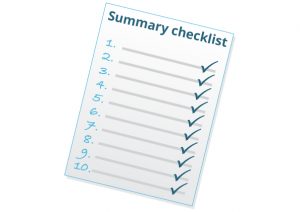
- Identify the document. Have you put the words ‘PRESS RELEASE’ at the top, in caps, centred and bold type?
- Make sure you say who you are and where you come from. Have you placed your organisation’s name prominently in the opening section?
- Include the date of release. Have you marked clearly the time and date when you want your release to be published?
- Make sure your headline is compelling. Does it tell the story and grab attention? Is it short and simple and no more than ten words? Does it convey the key point raised in your opening paragraph?
- Check your opening paragraph contains the gist of your announcement. Have you put all the key information in this paragraph and answered all the key 6W questions?
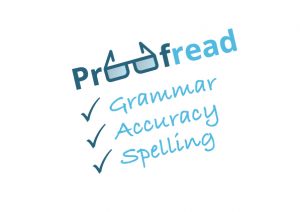 Read the body of your text carefully. Have you sufficient details to flesh out the story which you outlined in the first paragraph?
Read the body of your text carefully. Have you sufficient details to flesh out the story which you outlined in the first paragraph?- Check your quotes. Have you verified they are accurate?
- Is there any extra relevant information you should include?
- Check your last paragraph is conclusive. Does it provide the vital facts about your event, product or service?
- You may wish to add Notes for editor. Do you have additional background information about you and your organisation to include?
- Make sure you provide and verify contact details. Have you included the appropriate name, email, mobile and landline phone number and website address.
- Finally, spell check your article. Have you checked your text for mistakes and costly errors? Have you made sure names and titles are accurate, and taken time to check your grammar?
What you should avoid
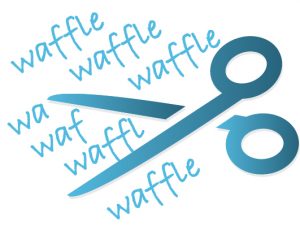 Resist the temptation to use gimmicks. Avoid so called “hype flags” in your press releases. Exclamation marks, hyperbole, or describing your product as AMAZING, using upper case characters to create emphasis — all challenge the credibility of your news announcement.
Resist the temptation to use gimmicks. Avoid so called “hype flags” in your press releases. Exclamation marks, hyperbole, or describing your product as AMAZING, using upper case characters to create emphasis — all challenge the credibility of your news announcement.- Use pronouns sparingly and thoughtfully. Steer clear of personal pronouns unless they appear within a quotation from a spokesperson from your organisation. Your press release should be written in the third person.
- Don’t Beat Around the Bush. Make your point clearly and remove any words, phrases and approaches that don’t help to clarify your point immediately. Cut the waffle.
- Get rid of jargon. Jargon makes your press release difficult to understand and inaccessible for many readers. Cut it out wherever possible. If it’s essential, explain.
- Steer clear of acronyms. They can confuse. Is a PC a personal computer or a police constable? Many organisations trade under their acronym. The first time you mention the acronym, precede it with the full title. For example, the Royal National Lifeboat Institution (RNLI).
And finally…
- Make sure your press release has been proofread and edited carefully. Most people need a second pair of eyes but, if you’re on your own, try reading your words out aloud, or come back to it a day later. You’ll be surprised how many errors you’ve failed to spot first time round. You can find out more about proofreading from the Society for Editors and Proofreaders.
- Spacing. It’s good practice to use double spacing and wide margins. This helps the journalist to make notes and presents your story clearly.
- Always place your release in the body of the email. It’s quicker to access and less likely to be lost. Don’t send it as an attachment.
- Send out your press release several days in advance, but not too early. It may get lost in the pile.
- Availability. Do make yourself available once your press release reaches its destination. If you are in a meeting, leave a recorded message on your mobile phone saying when you will be able to return calls and provide further information.
